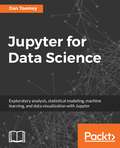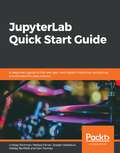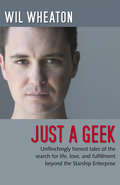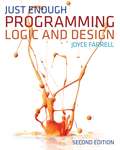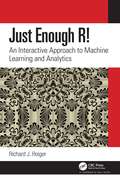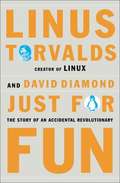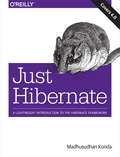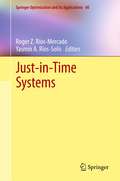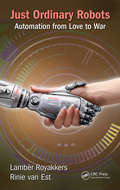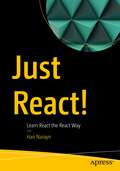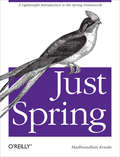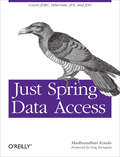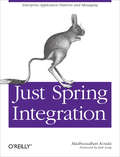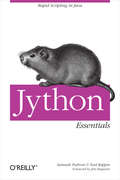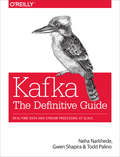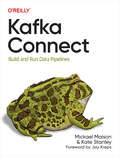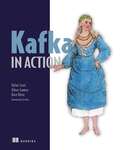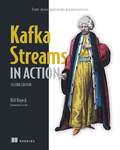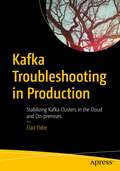- Table View
- List View
Jupyter for Data Science
by Dan ToomeyThis book is meant for students as well as professionals, who wish to master the use of Jupyter to perform a variety of data science tasks. Some programming experience with R or Python, and some basic understanding of Jupyter is all you need to get started with this book.
JupyterLab Quick Start Guide: A beginner's guide to the next-gen, web-based interactive computing environment for data science
by Lindsay Richman Melissa Ferrari Joseph Oladokun Wesley Banfield Dan ToomeyGet to grips with the basics of JupyterLab and its web interface with the help of this quick start guide Key Features Manage JupyterLab kernels, code consoles, and terminals, and share your work over the cloud Organize your data solutions within JupyterLab Install and configure extensions on JupyterLab using easy-to-follow examples Book Description JupyterLab is a web-based interface and the natural evolution of Jupyter Notebook. This guide will take you through the core commands and functionalities of JupyterLab and help you enhance your JupyterLab productivity. Starting with the installation of JupyterLab, this book will give you an overview of its features and the variety of problems it solves. You'll see how you can work with external files inside the platform, and understand how to use the code console and terminal. This will help you have distinct control over the scripts you work with. As you progress, you'll get to grips with the extensions available in JupyterLab, and gain insights into adding extensions to introduce new functionality in the interface. This book also covers widget operations within your document, different design patterns in JupyterLab, and the various methods for exchanging Notebooks. Additionally, you'll explore how to host JupyterLab Notebooks on GitHub. By the end of this Jupyter book, you'll have become well-versed with all the components of JupyterLab and be able to use it collaboratively within your data science teams. What you will learn Install JupyterLab and work with Jupyter Notebooks Host JupyterLab Notebooks on GitHub and access GitHub resources in your Notebooks Explore different methods for exchanging Notebooks Discover ways in which multiple users can access the same Notebook Publish your Notebooks with nbviewer and convert them into different formats Attach and operate widgets within your Notebooks using a JupyterLab document Use JupyterLab to work collaboratively with multiple data scientists in your teams Who this book is for This book is for data scientists and data analysts who are new to JupyterLab as well as for existing Jupyter users who want to get acquainted with its impressive features. Although not necessary, basic knowledge of Python will be helpful.
Just a Geek
by Wil WheatonWil Wheaton has never been one to take the conventional path to success. Despite early stardom through his childhood role in the motion picture "Stand By Me", and growing up on television as Wesley Crusher on "Star Trek: The Next Generation", Wil left Hollywood in pursuit of happiness, purpose, and a viable means of paying the bills. In the oddest of places, Topeka, Kansas, Wil discovered that despite his claims to fame, he was at heart Just a Geek. In this bestselling book, Wil shares his deeply personal and difficult journey to find himself. You'll understand the rigors, and joys, of Wil's rediscovering of himself, as he comes to terms with what it means to be famous, or, ironically, famous for once having been famous. Writing with honesty and disarming humanity, Wil touches on the frustrations associated with his acting career, his inability to distance himself from Ensign Crusher in the public's eyes, the launch of his incredibly successful web site, wilwheaton.net, and the joy he's found in writing. Through all of this, Wil shares the ups and downs he encountered along the journey, along with the support and love he discovered from his friends and family. The stories in Just a Geek include: Wil's plunge from teen star to struggling actor Discovering the joys of HTML, blogging, Linux, and web design The struggle between Wesley Crusher, Starfleet ensign, and Wil Wheaton, author and blogger Gut-wrenching reactions to the 9-11 disaster Moving tales of Wil's relationships with his wife, step-children, and extended family The transition from a B-list actor to an A-list authorWil Wheaton--celebrity, blogger, and geek--writes for the geek in all of us. Engaging, witty, and pleasantly self-deprecating, Just a Geek will surprise you and make you laugh.
Just a Journalist: On the Press, Life, and the Spaces Between (The William E. Massey Sr. lectures in American studies ; #2015)
by Linda GreenhouseA Pulitzer Prize–winning reporter who covered the Supreme Court for The New York Times, Linda Greenhouse trains an autobiographical lens on a moment of transition in U.S. journalism. Calling herself “an accidental activist,” she raises urgent questions about the role of journalists as citizens and participants in the world around them.
Just Enough Programming Logic and Design
by Joyce FarrellFind exactly what you need to master the fundamentals of programming logic with the concise JUST ENOUGH PROGRAMMING LOGIC AND DESIGN, 2E. This unique, language-independent introduction to programming logic provides seven chapters focused on key programming and logic content in a direct, efficient format that helps you progress through the subject matter quickly. Everyday examples and clear explanations in a streamlined presentation make this a perfect choice even if you have no prior programming experience. Twenty-five brief new videos from the author expand on and clarify topics, while new Debugging Exercises and a wealth of review and programming exercises in each chapter help you hone your skills. You can use this concise approach alone or as a companion book for success in any programming language course.
Just Enough R!: An Interactive Approach to Machine Learning and Analytics
by Richard J. RoigerJust Enough R! An Interactive Approach to Machine Learning and Analytics presents just enough of the R language, machine learning algorithms, statistical methodology, and analytics for the reader to learn how to find interesting structure in data. The approach might be called "seeing then doing" as it first gives step-by-step explanations using simple, understandable examples of how the various machine learning algorithms work independent of any programming language. This is followed by detailed scripts written in R that apply the algorithms to solve nontrivial problems with real data. The script code is provided, allowing the reader to execute the scripts as they study the explanations given in the text. Features Gets you quickly using R as a problem-solving tool Uses RStudio’s integrated development environment Shows how to interface R with SQLite Includes examples using R’s Rattle graphical user interface Requires no prior knowledge of R, machine learning, or computer programming Offers over 50 scripts written in R, including several problem-solving templates that, with slight modification, can be used again and again Covers the most popular machine learning techniques, including ensemble-based methods and logistic regression Includes end-of-chapter exercises, many of which can be solved by modifying existing scripts Includes datasets from several areas, including business, health and medicine, and science About the Author Richard J. Roiger is a professor emeritus at Minnesota State University, Mankato, where he taught and performed research in the Computer and Information Science Department for over 30 years.
Just for Fun: The Story of an Accidental Revolutionary
by Linus Torvalds David DiamondIn a narrative that zips along with the speed of e-mail, Torvalds gives a history of his renegade software while candidly revealing the quirky mind of a genius.
Just Hibernate
by Madhusudhan KondaIf you're looking for a short, sweet, and simple introduction (or reintroduction) to Hibernate, this is the book you want. Through clear real-world examples, you'll learn Hibernate and object-relational mapping from the ground up, starting with the basics. Then you'll dive into the framework's moving parts to understand how they work in action.Storing Java objects in relational databases is usually a challenging and complex task for any Java developer, experienced or not. This book, like others in the Just series, delivers a concise, example-driven tutorial for Java beginners. You'll gain enough knowledge and confidence to start working on real-world projects with Hibernate.Compare how JDBC and Hibernate work with object persistenceLearn how annotations are used to create Hibernate applicationsUnderstand how to persist and retrieve Java data structuresFocus on the fundamentals of associations and their mappingsDelve into advanced concepts such as caching, inheritance, and typesWalk through the Hibernate Query Language API, with examplesDevelop Java Persistence API applications, using Hibernate as the providerWork hands-on with code snippets to understand the technology
Just-in-Time Systems
by Yasmín A. Ríos-Solís Roger RiosWhether different types of costs are to be reduced, benefits to be maximized or scarce resources to be managed, scheduling theory provides intelligent methods for practitioners and scientists. The just-in-time (JIT) production philosophy has enriched the classical scheduling theory with models that consider characteristics such as inventory costs, set-up times, lot sizing, or maintenance. This edited volume considers the specifics of just-in-time systems. It provides knowledge and insights on recent advances in scheduling theory where just-in-time aspects are considered. Contributions on models, theory, algorithms, and applications, that bring the theory up-to-date on the state-of-the-art of JIT systems are presented. Professionals, researchers and graduate students will find this book useful.
Just Like Being There: A Collection of Science Fiction Short Stories (Science and Fiction)
by Eric ChoiJust Like Being There is the first collection of science fiction stories by award-winning author and aerospace engineer Eric Choi spanning his 25 year writing career. The stories are “hard” science fiction in which some element of engineering or science is so central there would be no story if that element were removed. Story topics include space exploration, artificial intelligence, virtual reality, cryptography, quantum computing, online privacy, mathematics (statistics), neuroscience, psychology, space medicine, extra-terrestrial intelligence, undersea exploration, commercial aviation, and the history of science. A special feature of the book is that each story is followed by an "Afterword" that explains the underlying engineering or science. This collection will entertain and inform all aficionados of science and science fiction.
Just Like Us: Digital Debates on Feminism and Fame
by Caitlin E. LawsonIn Just Like Us: Digital Debates on Feminism and Fame, Caitlin E. Lawson examines the rise of celebrity feminism, its intersections with digital culture, and its complicated relationships with race, sexuality, capitalism, and misogyny. Through in-depth analyses of debates across social media and news platforms, Lawson maps the processes by which celebrity culture, digital platforms, and feminism transform one another. As she analyzes celebrity-centered stories ranging from “The Fappening” and the digital attack on actress Leslie Jones to stars’ activism in response to #MeToo, Lawson demonstrates how celebrity culture functions as a hypervisible space in which networked publics confront white feminism, assert the value of productive anger in feminist politics, and seek remedies for women’s vulnerabilities in digital spaces and beyond. Just Like Us asserts that, together, celebrity culture and digital platforms form a crucial discursive arena where postfeminist logics are unsettled, opening up more public, collective modes of holding individuals and groups accountable for their actions.
Just Ordinary Robots: Automation from Love to War
by Lamber Royakkers Rinie van EstA social robot is a robot that interacts and communicates with humans or other autonomous physical agents by following social behaviors and rules attached to its role. We seem to accept the use of robots that perform dull, dirty, and dangerous jobs. But how far do we want to go with the automation of care for children and the elderly, or the killin
Just Peachy: Comics About Depression, Anxiety, Love, and Finding the Humor in Being Sad
by Holly Chisholm"In this autobiographical collection of thoughtful and poignant comic vignettes, Chisholm explores her experiences with depression, anxiety, and love ." —BooklistJust Peachy is a comic series that explores what the day-to-day is like with depression and/or anxiety. The all-too-real cartoon protagonist gives readers a character to empathize with, and helps explain some of the not often talked about consequences and symptoms of having depression. The comics also explore the themes of heartbreak, finding love, dealing with stress, and capturing the magical moments in life that keep us going.Through dark humor and cute illustrations, the subject matter becomes a bit more bearable, allowing for honest discussion about things like treatment and getting through anxiety attacks, and providing some comfort in times of struggle.For anyone affected by mental illness, Just Peachy shows that you are not alone. Simply put, this is an encouraging collection of comics about being just okay sometimes.&“So brave of Holly Chisholm to share her struggles with mental health issues through this creative medium. Just Peachy will inspire others to connect to, navigate through, and recover from their own day-to-day trials and tribulations of living with a mental illness. Well done!&” —Dr. Carlin Barnes and Dr. Marketa Wills, authors of Understanding Mental Illness and founders of Healthy Mind MDs
Just React!: Learn React the React Way
by Hari NaraynHere is your perfect companion for learning about and developing React applications. This book introduces concepts innovatively, using real-world examples based on the most recommended practices to help you establish a firm foundation. This comprehensive approach provides a strong focus on building components by using React hooks. You’ll begin by learning web fundamentals, next-generation JavaScript, and how React fits into this. In the chapters that follow, you’ll build a React application from scratch and learn about JSX, components, props, state management, prop drilling, context, and lifecycle events. Along the way you’ll build a multi-component app and see how the components interact. Debugging and styling React applications are also discussed. You’ll then take an in depth look at React hooks and see how to create a custom hook. There is also a penultimate chapter that explores important concepts such as routing and authentication. The book concludes with a review of some exciting features in the upcoming release of React 18. After reading Just React you will be equipped with the skills necessary to build complex web and mobile user interfaces using this flexible JavaScript library.What You’ll LearnExamine the details of modern React concepts through example projectsSet up your own React projectDebug and style React componentsTake a look at routing, authentication, HTTP requests, Redux, and the new features of React 18 Who This Book Is For Web developers, React developers, and JavaScript developers
Just Spring: A Lightweight Introduction to the Spring Framework (Oreilly And Associate Ser.)
by Madhusudhan KondaGet a concise introduction to Spring, the increasingly popular open source framework for building lightweight enterprise applications on the Java platform. This example-driven book for Java developers delves into the framework's basic features, as well as advanced concepts such as containers. You'll learn how Spring makes Java Messaging Service easier to work with, and how its support for Hibernate helps you work with data persistence and retrieval. Throughout Just Spring, you'll get your hands deep into sample code, beginning with a problem that illustrates dependency injection, Spring's core principle. In the chapters that follow, author Madhusudhan Konda walks you through features that underlie the solution. Learn dependency injection through a simple object coupling problem, along with different injection types Tackle the framework's core fundamentals, including beans and bean factories Dive into containers and other advanced concepts, such as event handling and autowiring beans Discover how Spring makes the Java Messaging Service API easier to use Learn how Spring has revolutionized data access with Java DataBase Connectivity (JDBC) Use Spring with the Hibernate framework to manipulate data as objects
Just Spring Data Access
by Madhusudhan KondaJDBC has simplified database access in Java applications, but a few nagging wrinkles remain--namely, persisting Java objects to relational databases. With this book, you'll learn how the Spring Framework makes that job incredibly easy with dependency injection, template classes, and object-relational-mapping (ORM). Through sample code, you'll discover how Spring streamlines the use of JDBC and ORM tools such as Hibernate, the Java Persistence API (JPA), and Java Data Objects (JDO). If you're a Java developer familiar with Spring (perhaps through O'Reilly's Just Spring tutorial) and want to advance your data access skills, this book shows you how. Learn how to use Spring's basic and advanced data access tools Work with Spring's JdbcTemplate class to separate non-critical code from business code Eliminate placeholder variables in your queries with the NamedParameterJdbcTemplate class Use Spring's template classes to perform batch executions Operate inserts on database tables without writing any SQL statements Learn about Spring's support for Hibernate as an object-relational-mapping tool Use JPA as a standards-based ORM--alone or with Spring support Move data from a relational to a non-relational database with JDO
Just Spring Integration
by Madhusudhan KondaGet started with Spring Integration, the lightweight Java-based framework that makes designing and developing message-oriented architectures a breeze. Through numerous examples, you'll learn how to use this open source framework's basic building blocks to work with both inter- and intra-application programming models. If you're a Java developer familiar with the Spring framework (perhaps through O'Reilly's Just Spring tutorial) and want to advance your skills with Enterprise Application Integration (EAI) patterns, and messaging systems in particular, this book is ideal. Learn Spring Integration fundamentals, including channels, endpoints, and messages Use message channels to decouple applications, separating producers from consumers Discover how common endpoint patterns separate a messaging application's business logic from integration details Create a seamless integration between the endpoints, using Transformers Implement Spring Integration's flow components to design your messaging application's business flow Configure the framework's File, FTP, JMS, and JDBC adapters to integrate with external systems
JXTATM in a Nutshell
by Li Gong Scott Oaks Bernard TraversatO'Reilly's pioneering reference is the first and last word on this powerful distributed computing technology. JXTA in a Nutshell delivers all the information you need to get started, including an overview of P2P distributed computing, an explanation of the JXTA Project's new platform, and ways that developers can become a part of the development effort. JXTA in a Nutshell introduces major concepts in a hands-on way by explaining them in context to the shell, and contains a complete reference to the JXTA app
Jython Essentials
by Samuele Pedroni Noel RappinJython is an implementation of the Python programming language written in 100% pure Java, so it runs under any compliant Java Virtual Machine. The secret to Jython's popularity lies in the combination of Java's libraries and tools with Python's rapid development capabilities. With Jython, you can write Python programs that integrate seamlessly with any Java code. And like Python, Jython can be used interactively, so you can get immediate results as you are programming. Jython Essentials provides a solid introduction to the Python language, offering a brief but thorough tour of the Python concepts you'll need to understand to use Jython effectively. The book makes frequent comparisons between Python and Java, with special emphasis on the different object-oriented semantics of the two languages, so Java programmers can quickly get up to speed with Jython. Jython Essentials also covers the various ways in which Jython and Java can interact. For example, Jython code can create instances of pre-existing Java classes and call methods in those instances. You can write Jython classes that are direct subclasses of existing Java classes and use introspection to discern the capabilities of JavaBeans components. This book provides examples of using Jython with existing Java libraries, including the Swing GUI toolkit, the JDBC database API, the Servlet API, and various XML tools. And finally, the book shows how Jython can be used as a scripting language within a Java program. With Jython Essentials, you have everything you need to start creating applications that mix the best of Python's interactivity and Java's robust libraries.
Kafka: Real-Time Data and Stream Processing at Scale
by Gwen Shapira Neha Narkhede Todd PalinoEvery enterprise application creates data, whether it’s log messages, metrics, user activity, outgoing messages, or something else. And how to move all of this data becomes nearly as important as the data itself. If you’re an application architect, developer, or production engineer new to Apache Kafka, this practical guide shows you how to use this open source streaming platform to handle real-time data feeds.Engineers from Confluent and LinkedIn who are responsible for developing Kafka explain how to deploy production Kafka clusters, write reliable event-driven microservices, and build scalable stream-processing applications with this platform. Through detailed examples, you’ll learn Kafka’s design principles, reliability guarantees, key APIs, and architecture details, including the replication protocol, the controller, and the storage layer.Understand publish-subscribe messaging and how it fits in the big data ecosystem.Explore Kafka producers and consumers for writing and reading messagesUnderstand Kafka patterns and use-case requirements to ensure reliable data deliveryGet best practices for building data pipelines and applications with KafkaManage Kafka in production, and learn to perform monitoring, tuning, and maintenance tasksLearn the most critical metrics among Kafka’s operational measurementsExplore how Kafka’s stream delivery capabilities make it a perfect source for stream processing systems
Kafka Connect
by Mickael Maison Kate StanleyUsed by more than 80% of Fortune 100 companies, Apache Kafka has become the de facto event streaming platform. Kafka Connect is a key component of Kafka that lets you flow data between your existing systems and Kafka to process data in real time.With this practical guide, authors Mickael Maison and Kate Stanley show data engineers, site reliability engineers, and application developers how to build data pipelines between Kafka clusters and a variety of data sources and sinks. Kafka Connect allows you to quickly adopt Kafka by tapping into existing data and enabling many advanced use cases. No matter where you are in your event streaming journey, Kafka Connect is the ideal tool for building a modern data pipeline.Learn Kafka Connect's capabilities, main concepts, and terminologyDesign data and event streaming pipelines that use Kafka ConnectConfigure and operate Kafka Connect environments at scaleDeploy secured and highly available Kafka Connect clustersBuild sink and source connectors and single message transforms and converters
Kafka in Action (In Action Ser.)
by Dylan Scott Viktor Gamov Dave KleinMaster the wicked-fast Apache Kafka streaming platform through hands-on examples and real-world projects.In Kafka in Action you will learn: Understanding Apache Kafka concepts Setting up and executing basic ETL tasks using Kafka Connect Using Kafka as part of a large data project team Performing administrative tasks Producing and consuming event streams Working with Kafka from Java applications Implementing Kafka as a message queue Kafka in Action is a fast-paced introduction to every aspect of working with Apache Kafka. Starting with an overview of Kafka's core concepts, you'll immediately learn how to set up and execute basic data movement tasks and how to produce and consume streams of events. Advancing quickly, you&’ll soon be ready to use Kafka in your day-to-day workflow, and start digging into even more advanced Kafka topics. About the technology Think of Apache Kafka as a high performance software bus that facilitates event streaming, logging, analytics, and other data pipeline tasks. With Kafka, you can easily build features like operational data monitoring and large-scale event processing into both large and small-scale applications. About the book Kafka in Action introduces the core features of Kafka, along with relevant examples of how to use it in real applications. In it, you&’ll explore the most common use cases such as logging and managing streaming data. When you&’re done, you&’ll be ready to handle both basic developer- and admin-based tasks in a Kafka-focused team. What's inside Kafka as an event streaming platform Kafka producers and consumers from Java applications Kafka as part of a large data project About the reader For intermediate Java developers or data engineers. No prior knowledge of Kafka required. About the author Dylan Scott is a software developer in the insurance industry. Viktor Gamov is a Kafka-focused developer advocate. At Confluent, Dave Klein helps developers, teams, and enterprises harness the power of event streaming with Apache Kafka. Table of Contents PART 1 GETTING STARTED 1 Introduction to Kafka 2 Getting to know Kafka PART 2 APPLYING KAFK 3 Designing a Kafka project 4 Producers: Sourcing data 5 Consumers: Unlocking data 6 Brokers 7 Topics and partitions 8 Kafka storage 9 Management: Tools and logging PART 3 GOING FURTHER 10 Protecting Kafka 11 Schema registry 12 Stream processing with Kafka Streams and ksqlDB
Kafka Streams in Action: Real-time apps and microservices with the Kafka Streams API
by Bill BejeckSummaryKafka Streams in Action teaches you everything you need to know to implement stream processing on data flowing into your Kafka platform, allowing you to focus on getting more from your data without sacrificing time or effort.Foreword by Neha Narkhede, Cocreator of Apache KafkaPurchase of the print book includes a free eBook in PDF, Kindle, and ePub formats from Manning Publications.About the TechnologyNot all stream-based applications require a dedicated processing cluster. The lightweight Kafka Streams library provides exactly the power and simplicity you need for message handling in microservices and real-time event processing. With the Kafka Streams API, you filter and transform data streams with just Kafka and your application.About the BookKafka Streams in Action teaches you to implement stream processing within the Kafka platform. In this easy-to-follow book, you'll explore real-world examples to collect, transform, and aggregate data, work with multiple processors, and handle real-time events. You'll even dive into streaming SQL with KSQL! Practical to the very end, it finishes with testing and operational aspects, such as monitoring and debugging. What's insideUsing the KStreams APIFiltering, transforming, and splitting dataWorking with the Processor APIIntegrating with external systemsAbout the ReaderAssumes some experience with distributed systems. No knowledge of Kafka or streaming applications required.About the AuthorBill Bejeck is a Kafka Streams contributor and Confluent engineer with over 15 years of software development experience.Table of ContentsPART 1 - GETTING STARTED WITH KAFKA STREAMS Welcome to Kafka StreamsKafka quicklyPART 2 - KAFKA STREAMS DEVELOPMENT Developing Kafka StreamsStreams and stateThe KTable APIThe Processor APIPART 3 - ADMINISTERING KAFKA STREAMS Monitoring and performanceTesting a Kafka Streams applicationPART 4 - ADVANCED CONCEPTS WITH KAFKA STREAMS Advanced applications with Kafka StreamsAPPENDIXESAppendix A - Additional configuration informationAppendix B - Exactly once semantics
Kafka Streams in Action, Second Edition (In Action)
by Bill BejeckEverything you need to implement stream processing on Apache Kafka using Kafka Streams and the kqsIDB event streaming database.Kafka Streams in Action, Second Edition guides you through setting up and maintaining your streaming processing with Kafka. Inside, you&’ll find comprehensive coverage of not only Kafka Streams, but the entire toolbox you&’ll need for effective streaming—from the components of the Kafka ecosystem, to Producer and Consumer clients, Connect, and Schema Registry. In Kafka Streams in Action, Second Edition you&’ll learn how to: Design streaming applications in Kafka Streams with the KStream and the Processor API Integrate external systems with Kafka Connect Enforce data compatibility with Schema Registry Build applications that respond immediately to events in either Kafka Streams or ksqlDB Craft materialized views over streams with ksqlDB This totally revised new edition of Kafka Streams in Action has been expanded to cover more of the Kafka platform used for building event-based applications. You&’ll also find full coverage of ksqlDB, an event streaming database that makes it a snap to create applications that respond immediately to events, such as real-time push and pull updates. Foreword by Jun Rao. About the technology Enterprise applications need to handle thousands—even millions—of data events every day. With an intuitive API and flawless reliability, the lightweight Kafka Streams library has earned a spot at the center of these systems. Kafka Streams provides exactly the power and simplicity you need to manage real-time event processing or microservices messaging. About the book Kafka Streams in Action, Second Edition teaches you how to create event streaming applications on the amazing Apache Kafka platform. This thoroughly revised new edition now covers a wider range of streaming architectures and includes data integration with Kafka Connect. As you go, you&’ll explore real-world examples that introduce components and brokers, schema management, and the other essentials. Along the way, you&’ll pick up practical techniques for blending Kafka with Spring, low-level control of processors and state stores, storing event data with ksqlDB, and testing streaming applications. What's inside Design efficient streaming applications Integrate external systems with Kafka Connect Enforce data compatibility with Schema Registry About the reader For Java developers. No knowledge of Kafka or streaming applications required. About the author Bill Bejeck is a Confluent engineer and a Kafka Streams contributor with over 15 years of software development experience. Bill is also a committer on the Apache Kafka? project. Table of Contents PART 1 1 Welcome to the Kafka event streaming platform 2 Kafka brokers PART 2 3 Schema Registry 4 Kafka clients 5 Kafka ConnectPART 3 6 Developing Kafka Streams 7 Streams and state 8 The KTable API 9 Windowing and timestamps 10 The Processor API 11 ksqlDB 12 Spring kafka 13 Kafka Streams Interactive Queries 14 Testing
Kafka Troubleshooting in Production: Stabilizing Kafka Clusters in the Cloud and On-premises
by Elad EldorThis book provides Kafka administrators, site reliability engineers, and DataOps and DevOps practitioners with a list of real production issues that can occur in Kafka clusters and how to solve them. The production issues covered are assembled into a comprehensive troubleshooting guide for those engineers who are responsible for the stability and performance of Kafka clusters in production, whether those clusters are deployed in the cloud or on-premises. This book teaches you how to detect and troubleshoot the issues, and eventually how to prevent them.Kafka stability is hard to achieve, especially in high throughput environments, and the purpose of this book is not only to make troubleshooting easier, but also to prevent production issues from occurring in the first place. The guidance in this book is drawn from the author's years of experience in helping clients and internal customers diagnose and resolve knotty production problems and stabilize their Kafka environments. The book is organized into recipe-style troubleshooting checklists that field engineers can easily follow when under pressure to fix an unstable cluster. This is the book you will want by your side when the stakes are high, and your job is on the line. What You Will LearnMonitor and resolve production issues in your Kafka clustersProvision Kafka clusters with the lowest costs and still handle the required loadsPerform root cause analyses of issues affecting your Kafka clustersKnow the ways in which your Kafka cluster can affect its consumers and producersPrevent or minimize data loss and delays in data streamingForestall production issues through an understanding of common failure pointsCreate checklists for troubleshooting your Kafka clusters when problems occurWho This Book Is ForSite reliability engineers tasked with maintaining stability of Kafka clusters, Kafka administrators who troubleshoot production issues around Kafka, DevOps and DataOps experts who are involved with provisioning Kafka (whether on-premises or in the cloud), developers of Kafka consumers and producers who wish to learn more about Kafka
